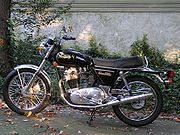
Norton Isolastic frame
Encyclopedia

Featherbed frame
The featherbed frame was a motorcycle frame developed by the British Norton motorcycle company to improve the performance of their racing motorcycles around the twisting and demanding Isle of Man TT course in 1950. It was considered revolutionary at the time, and the best handling frame that a...
was replaced by an Isolastic frame Norton Motorcycles for use in the Norton Commando
Norton Commando
The Norton Commando is a British motorcycle with an ohv pre-unit parallel twin engine, launched by the Norton Motorcycle company in 1967. Initially a nominal 750 cc displacement, actually , in 1973 it became an 850 cc, actually ....
.
In an attempt to reduce the problem of engine vibration being transmitted through the frame, as the capacity of the motorcycle engines increased to 750cc with the Norton Atlas
Norton Atlas
The Norton Atlas was a Norton motorcycle made by between 1962 and 1968, until it was replaced by the Norton Commando.-Development:The Mark 1 Atlas was launched as the 750SS in the early 1960s. Designer Bert Hopwood’s 497cc Dominator engine was bored and stroked out to 745cc, via 600cc and then...
, Norton decided to look at changes to the Featherbed frame and the 1969 Norton Commando
Norton Commando
The Norton Commando is a British motorcycle with an ohv pre-unit parallel twin engine, launched by the Norton Motorcycle company in 1967. Initially a nominal 750 cc displacement, actually , in 1973 it became an 850 cc, actually ....
was the result. The innovative isolastic frame derived from the Featherbed made it much smoother through the use of rubber bushings to isolate the engine and swingarm from the frame, forks, and rider. As the rubber bushings wore, however, the bike became prone to fishtailing in high-speed turns. Earlier models therefore required careful adjustment of the clearance between frame and mounts using shims.
The later Mark III Commandos had a threaded adjuster that made this easier. The swinging arm was also mounted to the cradle to prevent lateral twisting causing misalignment of the drive sprockets leading to rapid chain wear and stress. It was a rushed design but despite steering head fractures on 1968 and 1969 models the Commando was a success.

